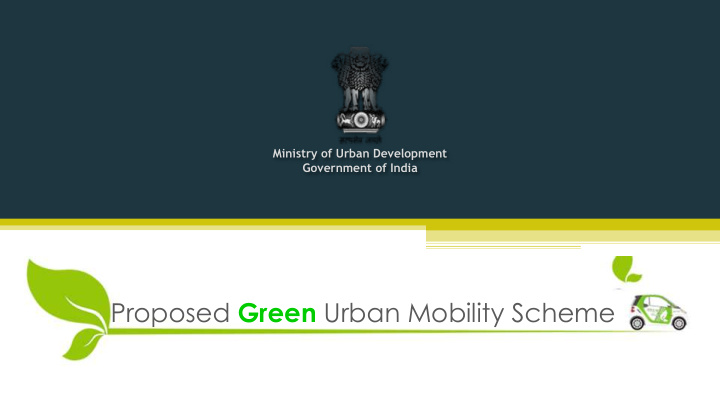



Ministry of Urban Development Government of India Proposed Green Urban Mobility Scheme
Rationale Need to Address much required mobility needs of cities. • infrastructure for Bus based transport – depots, maintenance facilities, ITS etc. • bring in private entrepreneurial spirit in operations • promote Non motorized Transport (NMT), Last mile connectivity • promote alternate fuels, Electric Mobility for better environment • focus on Urban Freight Over 195,000 fatalities in road accidents in urban areas, of which • address high fatalities of pedestrians. 70% are pedestrians, cyclist and 2w Therefore, need a separate sustainable urban mobility scheme having pan city coverage with emphasis on improving access of citizens
Indicative Components of Green Urban Mobility Scheme Sustainable Vehicles Sustainable Urban 2 1 and Fuels Mobility Shift to electric/hybrid Infrastructure enabling vehicles for public bus systems (excluding transport buses) Safe Pedestrian Shift to Non-fossil fuel pathways, cycling track, for public transport public bike sharing projects Integrating modes with physical & soft Any other project infrastructure e.g 3 cashless payment demonstrating systems & ITS reduction in GHG emissions Strategies for Urban Freight management Projects will be identified by cities depending upon their size, sprawl , demand and other techno-economic criteria
Coverage & Funding Requirement Coverage: Cities with Population > 103 500,000 (2011) + State Capitals = 103 Estimated Project Costs Rs Cr 70,000 2018-19 Initial Projects Implementation To 2022- duration -7 years 23 Fund disbursement to be done based on drawdown schedule given in DPRs & subject to physical progress.
Proposed Scheme Structure Contribution from GOI Green Climate Funds Fund Manager Pooled Urban Mobility Fund Multilateral/Bilateral Agencies Others Contribution from State Entity nominated by the State PMU Statutory Levies Government Bonds Grant +Concessional Loans Land Monetization/VCF Project -1 User Charges Project -2 Local Cess Project -3 Municipal Budget
Proposed Scheme Structure 70,000 Total Project Cost (Rs in Cr) Indicative Cities Central Govt. States Contributions 7,000 (10%) 49,000 (70%) 14,000 (20%) 14,000 - Grant from GOI* Municipal budget, Land State grant , statutory Sources 35,000 -Line of credit from monetization, user levies, bonds charges, local cess multilateral agencies Pooled Urban Pooled Urban Mobility Fund Mobility Fund In proportion of 50:50 (# Cities & Urban Population) Maximum eligibility of States State Level Nodal Agency Maharashtra Orissa Uttar Pradesh Gujarat Punjab *will be in terms of annual commitment & not be housed with fund or States/cities and will be reimbursed to the cities on achieving the implementation milestones
City Selection Process • Cities to be selected through a “Green Mobility Challenge” (GMC) • Cities to submit “Green Mobility Plan” (GMP) for evaluation • Fund to prioritize the cities based on score obtained • Cities in each group will compete only with cities within the groups Group-1 : Cities in Hilly/NE &UTs (excluding NCT Delhi, Chandigarh); Group-2 : Cities population less than 1 million; and Group-3 : Cities population more than 1 million including NCT Delhi, Chandigarh) • Approved cities will prepare DPR s to be appraised and approved for investment at State level • Indicative Conditions precedents for Green Mobility Challenge • Green Mobility Plan (GMP) to be approved by UMTA (for million plus cities); • State undertaking for financial assistance and guarantees • Elected city council’s resolution supporting the GMP; and • Report on outcome of the citizen’s consultation process • Commitment with timelines on reforms
Expected Outcomes UT Financing and Sustainable transport accessibility to nearly 58% of urban population Institutional Pedestrian and Public Transport Facilities Strengthening Cycling facilities Improved and cleaner PT across 106 cities 8,000+ kms of footpath 1,000+ kms of 550 Depots across Setting up of UMTA and cycle tracks BRT Network 103 cities across 53 cities across across 103 cities 28 cities BRT 73,000+ public cycles Real time 20,000 para transit and Permanent funding for across PIS, AVLS, cashless 6000 buses on UT financing 58 cities ticketing alternate fuel/ and O&M across electric 103 cities across 103 cities
Proposed Reforms Setting up of and operationalizing Adoption and implementation of an UMTA Encroachment policy aimed at ensuring availability of full right of way Adoption of Travel Demand Preparation of Comprehensive Management measures (Parking policy, congestion pricing etc.) Mobility Plans and integration of the same with Master Plan of the city/town Adoption and implementation of policy for Urban Street Adoption and implementation of Transit Vendors Oriented Development Setting up of UT fund
Thank You
Recommend
More recommend